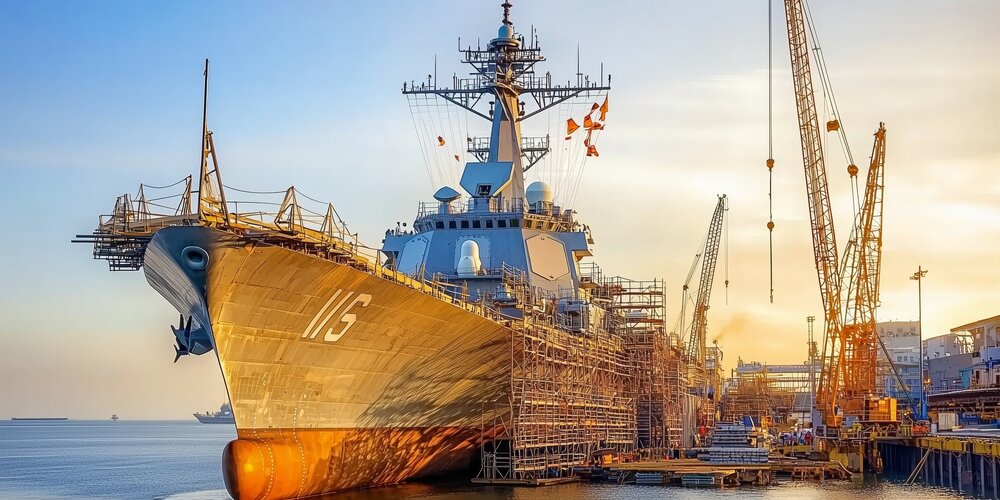
Heavy Lifting in Shipbuilding – Safety in Confined Spaces and Dry Docks
Shipbuilding and dry dock operations involve complex, lifting in spatially restricted and corrosive marine environments. Tasks such as positioning hull modules, engine blocks, propulsion systems, and auxiliary structures necessitate engineered lifting solutions designed to ensure structural integrity, regulatory compliance, and operational continuity under challenging conditions.
Operational Challenges in Marine Lifting Environments
Heavy, Asymmetrical Load Profiles
Marine lifting operations frequently involve large, unevenly weighted assemblies such as propulsion units, hull blocks, and deckhouse structures. These components often present high centres of gravity and non-uniform load paths, demanding precision in rigging configuration and lifting technique.
Restricted Spatial Parameters
Dry dock constraints and confined ship layouts impose significant limitations on headroom, lifting angles, and swing radii. These restrictions heighten the risk of collision, mechanical interference, and compromised load control during lifting sequences.
Corrosive Maritime Conditions
Lifting equipment is routinely exposed to salt-laden air and high humidity, accelerating wear mechanisms including galvanic corrosion, pitting, and micro-crack propagation. Material selection and maintenance protocols must account for these aggressive environmental factors.
Advanced Rigging Complexity
Marine lifts often require multi-point, tandem, or synchronised lifting arrangements. These configurations necessitate comprehensive load path analysis, coordinated hoisting control, and real-time monitoring to mitigate instability, dynamic loading, and the potential for mechanical overstress.
Specified Lifting Equipment for Shipbuilding and Dry Docking
High-Capacity Slings and Chain Assemblies
-
Use polyester or high-modulus polyethylene (HMPE) slings with abrasion-resistant sleeves, and reinforced eye terminations for enhanced durability in harsh environment.
-
Alloy steel chain slings (Grade 80 or 100) should be selected based on WLL (Working Load Limit) requirements and must incorporate shortening devices for load equalisation.
Multi-Leg Sling Assemblies and Spreader Systems
-
Utilise modular or adjustable spreader beams designed to distribute forces evenly across asymmetric load centres, ensuring structural stability during lifting.
-
Multi-leg sling configurations—whether chain (in accordance with BS EN 818) or wire rope (referencing BS EN 13414)—must be selected based on calculated load angles, factoring in leg tension, centre of gravity offsets, and dynamic conditions.
Low-Headroom Lifting Solutions
-
Specify ultra-low headroom electric chain hoists or air-powered hoists with precision load control for restricted access zones.
-
Gantry systems and compact overhead cranes may be required where permanent crane access is limited.
Specialised Hooks and Marine Attachments
-
Use swivel load hooks to mitigate torsional stress on lifting media.
-
Galvanised, stainless-steel, or marine-coated shackles, clamps, and plate grips are required to maintain integrity in marine atmospheres.
Inspection & Preventative Maintenance Protocols
To ensure operational reliability and compliance with LOLER (1998), a typical inspection regime may include the following elements:
Daily Pre-Operational Checks
-
Visual assessment of lifting accessories for fraying, corrosion, or mechanical deformation.
-
Verification of attachment integrity and locking mechanisms on clamps and lifters.
6-Month Statutory Thorough Examination (LOLER)
-
Inspection of slings, chains, and auxiliary lifting equipment.
-
Annual equipment that falls under a written scheme of examination and any lifting equipment used for lifting personnel.
12-Month Thorough Examination (LOLER)
-
Full mechanical and structural assessment of fixed and mobile lifting equipment, including overhead cranes and electric hoists.
Post-Lift or Incident-Based Inspection
-
Non-destructive testing (NDT) or dimensional checks on components suspected of having undergone overloading, deformation, or environmental stress (e.g. elongation, fatigue cracks, corrosion pitting).
Written Schemes of Examination (WSE)
Under Regulation 9 of LOLER, lifting equipment used in shipbuilding and dry dock environments may require a Written Scheme of Examination (WSE), particularly where equipment is exposed to high-risk conditions such as confined compartments, variable load handling, corrosive atmospheres, or complex rigging scenarios. A WSE is essential for equipment subject to frequent use, severe environmental exposure, or irregular loading patterns.
The WSE must be prepared and certified by a competent person and should include the following elements:
Defined Scope and Inspection Frequency
Clearly identify the lifting equipment covered—such as overhead gantry cranes, jib cranes, chain blocks, mobile hoists, spreader beams, and lifting accessories—along with the required intervals for thorough examination.
Critical Components to Inspect
Detail key wear-prone or high-risk components, including load chains, wire ropes, sheaves, hooks, shackles, lifting lugs, and hydraulic systems. Pay particular attention to parts exposed to saltwater spray, weld spatter, grit blasting debris, or mechanical strain.
Examination Techniques
Specify appropriate inspection methods, which may include visual examination, non-destructive testing (NDT), functional checks, or proof load testing, depending on equipment type and usage conditions.
Trigger Conditions for Unscheduled Inspections
Outline circumstances requiring immediate or unscheduled inspections—such as post-collision events, overload incidents, ingress of seawater, exposure to high heat from welding or cutting, or any deviation from normal operation.
Document Management
The WSE should be treated as a living document, regularly reviewed and updated to reflect changes in operational procedures, equipment modification, incident investigations, or shifts in duty cycles.
Safety and Procedural Controls for Confined and Heavy Lifting
Load Verification and Risk Assessment
Confirm the actual load mass and COG using load indicators or calculation software, and validate against the WLL and SWL of lifting assemblies.
Communication Protocols
Employ duplex radio communication, hand signal standards (e.g., BS 7121), or synchronised lift control systems for multi-lift operations.
Access/Egress Control
Establish clear emergency escape routes in confined compartments, with lighting and obstruction-free zones during lift operations.
Competency and Authorisation
Ensure personnel are trained to current lifting standards (e.g., LEEA, LOLER, PUWER) and demonstrate competence in complex lift planning, execution, and supervision.
To conclude, Marine and shipyard lifting environments demand technically advanced, corrosion-resistant, and low-profile lifting solutions tailored for extreme weights and tight operational tolerances. With strict inspection regimes and operator competence, lifting risks can be mitigated to ensure efficient production schedules and safe work environments.
Need a shipyard-specific solution?
Certex offers over 35 years of specialised expertise supplying engineered lifting systems, certified inspection services, and industry-recognised training for marine and shipbuilding operations. Get in touch today



